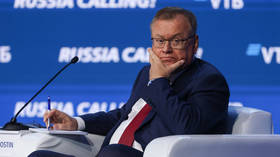Euro hits historic low in SWIFT transactions

The share of the euro currency in global cross-border settlements via the SWIFT messaging system last month declined to an all-time low, transaction data compiled by the global financial service showed on Thursday.
The portion of transactions involving the European single currency amounted to 21.93% in March, marking a month-over-month decline by 1.32 percentage points and dropping well below the 24.4% level logged when SWIFT introduced the new scale.
The data has been collected since 2010, but since July the figures reflect a technical adjustment by SWIFT to trade-reporting standards.
Over the past year, the euro’s share in international payments has nearly halved. In January 2023, settlements with the currency stood at 37.88%, while figures for December 2023 registers a drop to 22.41%.
The US dollar ranked first, gaining 0.81 percentage points from February to reach 47.37% and marking the highest level since December 2023. It was followed by the euro, pound and yuan currencies.
The share of the UK national currency in transactions conducted by SWIFT amounted to 6.57%, while the portion of settlements with Chinese yuan saw another increase, reaching 4.69%.
The dominance of the euro, a distant second after the US dollar, as a global currency, has been shaken by the rise of China, as well as by the deterioration of ties with Russia and the notable efforts to attain financial independence pursued by emerging economies from India to Brazil.
In Russia, major banks controlling over 80% of country’s banking assets were cut off from SWIFT as part of Ukraine-related sanctions. This, according to financial experts, has propelled the increase of China’s national currency in global trade and finance, as Beijing hasn’t joined the sanctions, opting to strengthen trading ties with Russia.
The use of yuan has been enlarged after China developed its own international-payments network CIPS, separate from SWIFT. CIPS has been welcomed not only by banks in sanctions-hit Russia, but also by financial institutions operating across emerging economies. The move has boosted the rise of the yuan as one of the world’s most used currencies.
SWIFT, or the Society for Worldwide Interbank Financial Telecommunication, provides financial transaction and payment services for more than 11,000 global financial organizations. The tracked data doesn’t blanket the entirety of the $7.5 trillion-per-day foreign-exchange market, but the reports commonly span the vast pools of currency flows that drive global trade over time.














